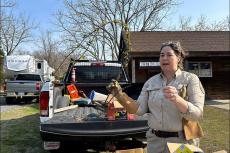Last week the number of water bodies in Montauk and Amagansett with harmful levels of enterococcus bacteria increased, according to Concerned Citizens of Montauk, and a harmful blue-green algae bloom was in Kellis Pond in Bridgehampton.
C.C.O.M. tests water bodies in Montauk, Amagansett, and East Hampton for the bacteria enterococcus. Entero levels at 104 and above are considered a risk to human health.
In the week beginninng June 21, C.C.O.M. took samples during a fairly high tide, according to Kate Rossi-Snook of C.C.O.M. High tides can wash animal excrement from the shore into the water, leading to higher bacteria levels. These elevated levels were seen in several Montauk and Amagansett water bodies that were tested. Any bacteria level above 104 is deemed "high bacteria" and poses a risk to human health.
The highest entero levels were at the East Creek area of Lake Montauk, where bacteria concentration grew from 109 to 3,130, by the Spring General Store on Accabonac Harbor, where the level was 231, at the Northwest Creek culvert, where the level was 121.
The number of Montauk water bodies with risky levels of bacteria doubled from three to six out of the 11 tested last week. Many Montauk test sites had higher bacteria levels than the previous week, especially locations at Lake Montauk. All six Lake Montauk test areas had medium or high levels of bacteria. In addition to the East Creek site, bacteria levels were high at Little Reed Pond creek, where they grew from 31 to 108. The South Beach, West Creek, and Stepping Stone locations, which last week all had bacteria levels of 0, increased to medium levels.
Out of four sites tested in Amagansett, three showed medium levels of bacteria. Levels at the Napeague Harbor east and west locations grew from 0 to 20 and 0 to 75, respectively. Fresh Pond bacteria concentration at the beach and creek testing sites decreased from high to medium levels.
In East Hampton and Springs, three of seven test areas showed medium or high levels of bacteria. There was a decrease in levels at Louse Point, which registered as low risk, while the Shipyard Lane ramp, also at Accabonac Harbor, showed an increase from low to medium levels.
All Three Mile Harbor testing sites showed low bacteria levels.
C.C.O.M. also monitors Fort Pond and Big Reed Pond for harmful cyanobacteria, or blue-green algae blooms. Last week, all tested locations reported low risk of blooms, consistent with the previous week's testing. However, the Suffolk County Health Department reported a new cyanobacteria bloom in Kellis Pond in Bridgehampton. Following confirmation of the bloom by Stony Brook University, the county has asked people not to swim or wade in the pond and to keep children and pets away from it. Blue-green algae are present low numbers in lakes and streams, but when blooms form can be harmful to people and animals. One indication that a bloom may be present is a floating paint-like scum on the water's surface.
Those who come in contact with such waters should immediately rinse off with clean water. "Seek medical attention if any of the following symptoms occur after contact: nausea, vomiting or diarrhea; skin, eye or throat irritation; or allergic reactions or breathing difficulties," the Health Department advises. A map of freshwater bodies in the state with cyanobacteria blooms can be found by clicking here.
Suspected blooms at water bodies without bathing beaches can be reported to the New York State Department of Environmental Conservation by emailing [email protected] or to the County Health Department's office of ecology at [email protected] or by calling 631-852-5760 between 8:30 a.m. and 4:30 p.m.



